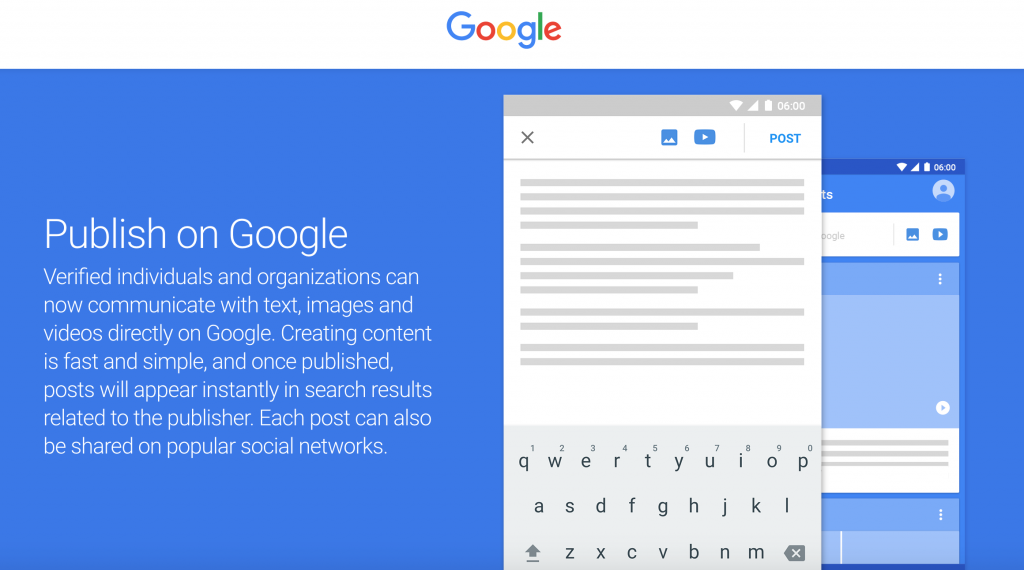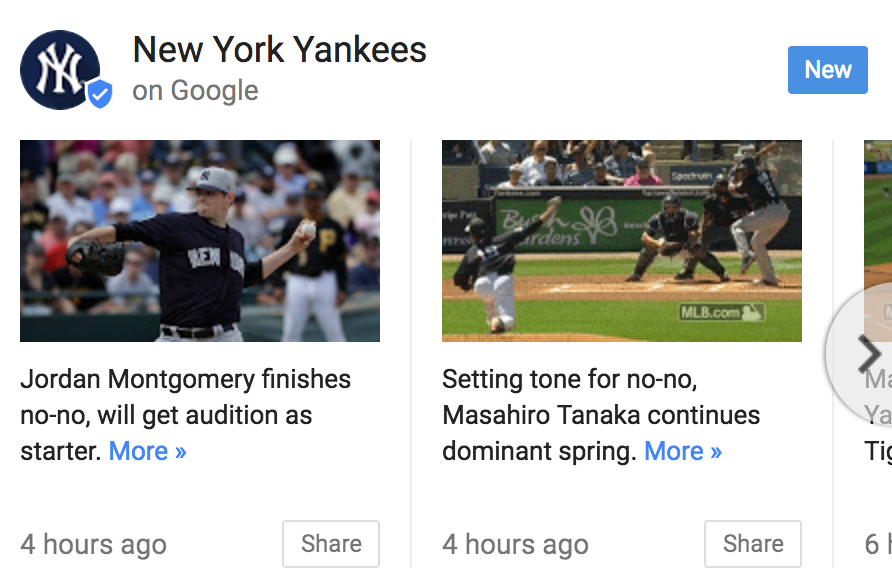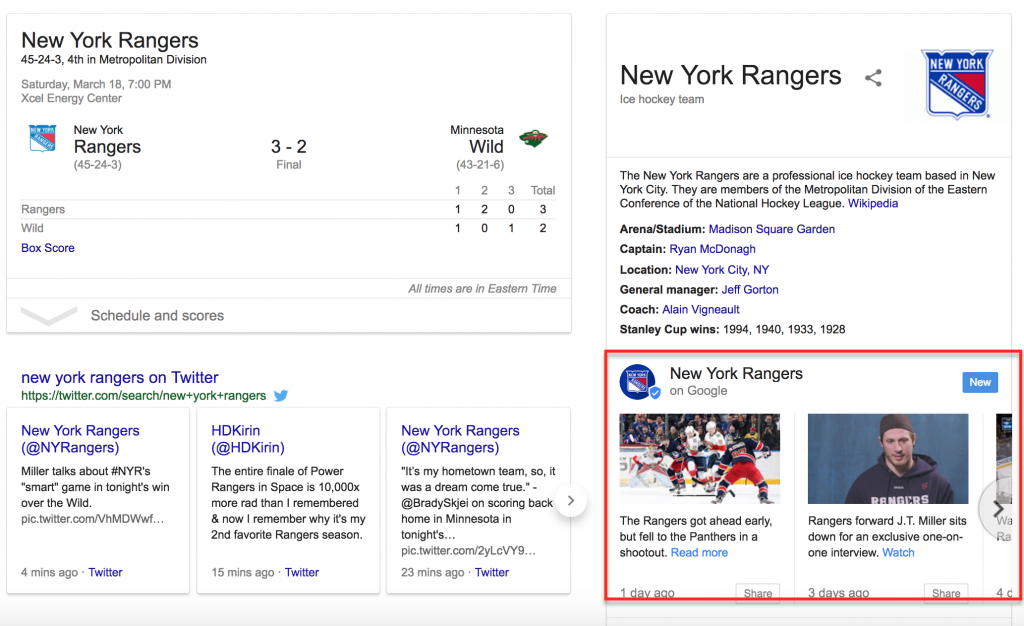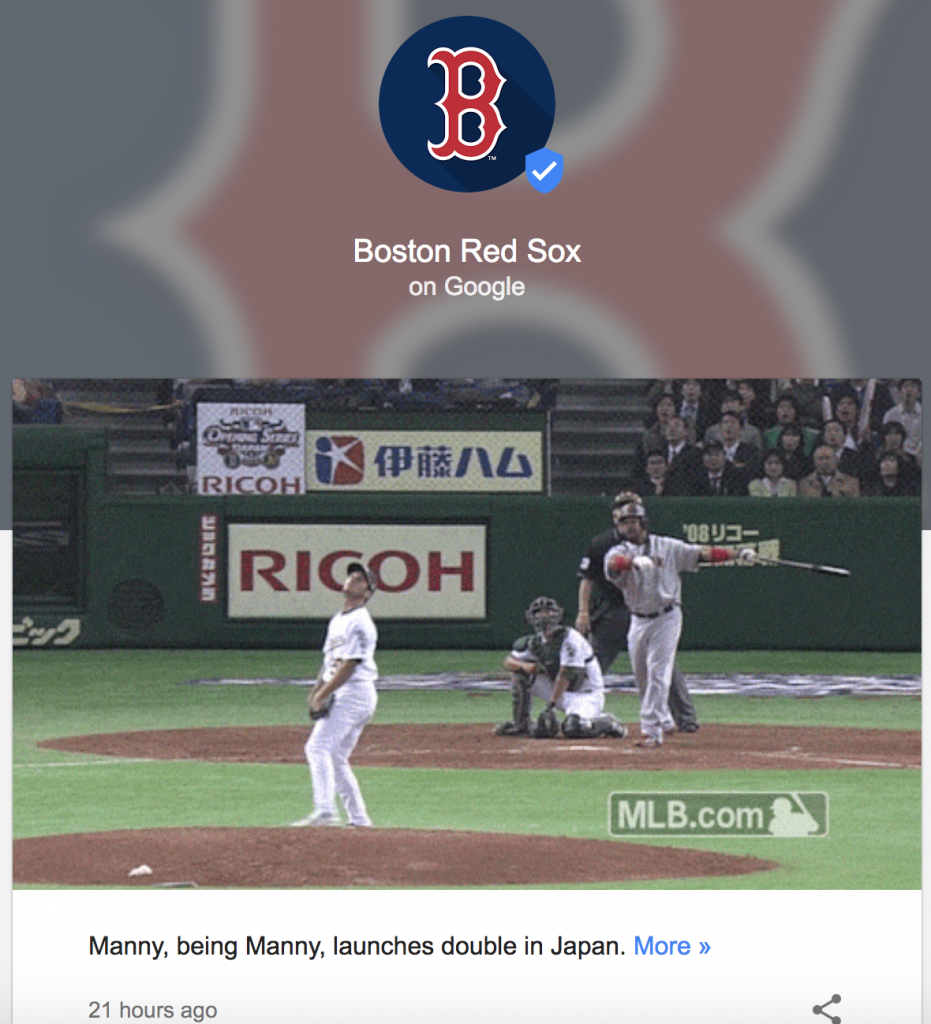Google Posts: GIFs and Videos published directly to SERPs
To relatively little fanfare, Google launched its “Posts” initiative during the US presidential election campaign last year.
The launch was accompanied by a landing page that labeled this “an experimental new podium”. That same landing page remains live, unchanged, and with the same call to action at its conclusion to “Join the Waitlist”.
Google Posts seemed to be a stripped-back version of Google+, devised with the intention of at least maintaining some of the functionality of a social network after sunsetting Google+.
The main premise of Posts had ostensibly been to work as a one-way social platform, where brands or individuals could publish (and be indexed instantly), but without the requisite mechanisms to allow the audience to engage in conversation with the poster or ‘like’ the update.
Since that tentative launch, Posts has perennially appeared in and disappeared from the SERPs in various guises, each time with very little fanfare. It initially appeared to be being trialed by a select few small businesses, then was spotted during Google I/O the following May, being used to publish live conference updates directly to the SERP.
A few months after that, Google Posts reappeared in search results for a charter school in New York, KIPP NYC, and then disappeared again. Each time, users have remained in the dark about whether a fully-fledged roll-out of Google Posts might be on the horizon, and nothing much has happened in this space to justify the tag ‘experimental new podium’. However, that may be set to change.
I noticed during a routine search for [red sox] that gifs were autoplaying within the knowledge graph sidebar, both on desktop (as in the screenshot below) and also on mobile.
This is particularly eye-catching and is in line with numerous other Google initiatives to bring a sense of vitality and immediacy to its results, most notably in the shape of Accelerated Mobile Pages and the decision to allow emoji in select organic results.
Although the Posts initiative itself is not new and nor is its inclusion within search results, there is a clearly-labeled ‘New’ box in the top right of this section to alert users of a change.
The same was observed for [yankees], so at least Google shows no clear bias in that sense:
This has been spotted by others in the last few weeks, although it does seem that is being rolled out in a piecemeal fashion.
The two entities that appear to be taking part in this partnership with Google are Major League Baseball and the National Hockey League, as seen in the screenshot below in a search for the ice hockey team [new york rangers]:
If it’s new, what has changed?
GIFs were also spotted in SERPs on a few occasions when Google+ was up and running, but again this was isolated to a few brands, and it was clear that this was being pulled from their own Google+ account.
What is most noteworthy in this instance is that these results may not be showing up as a result of direct action from each individual sports team.
It is therefore worth assessing the source of the posts to ascertain whether brands will be expected to update their feed on an ongoing basis.
This is quite vital if we want to know where this platform could go in future, as it helps us define whether this is a streamlined social media network (more in line with Twitter than Facebook) or more of an automated content syndication platform.
Back to the Red Sox example for further investigation.
First of all, clicking on an individual post, as it appears within the SERP, opens up a larger window containing the image or GIF. As you can see from the screenshot below, this is all contained within the same results page:
Clicking on the ‘More’ link leads to the original post which, intriguingly, is hosted on MLB.com rather than the Red Sox Google Posts page.
As such, this could be a welcome boon for brands like Major League Baseball, who will undoubtedly receive increased traffic. This will be of great interest to publishers, as there is the tantalising possibility of a new avenue to get their content in search results, should the initiative go mainstream.
The Red Sox ‘profile page’ is really just a feed of images and external links to more in-depth content – all of which are hosted on MLB.com.
This arouses the suspicion that the functioning of Google Posts is changing, especially as this seems to be the case across all MLB teams. The same is also true of many ice hockey teams, which link out to NHL.com from all of their posts.
As a result, it is plausible that the partnership here is between the sites hosting the content (MLB.com, NHL.com) and Google, with the individual sports teams acceptant beneficiaries of the increased engagement.
In the initial announcement about Posts, the selling point was said to be that individuals or brands could publish directly to Google. That requires a certain complicity; one would have to take action to set this process in motion by posting content via Posts, whether fully-formed or just a link to an external site.
In our coverage from March 2016, we noted that a few small businesses had been given access to Google Posts. There didn’t appear to be much in the way of consistent rationale for choosing these particular businesses over others, although their feeds are all still live.
The fact that the links from the Red Sox are invariably from one website suggests that Google is automatically pulling these links through to its search results when they go live on MLB.com. This differs from the small business accounts, which are composed of unique updates written for Google Posts.
This demonstrates an important and telling distinction from the original functioning of Posts, and could be one with far-reaching implications.
What is Google seeking to accomplish through Posts?
The reasons for doing this are self-evident.
Eric Schmidt was very public in admitting that the company “missed the boat” on social media, their only real foray into the market being their overdue and (in hindsight) always-doomed Google+.
That is a substantial missing piece in the jigsaw for a company that is competing with Facebook to maintain its digital advertising dominance.
Speed is of the essence, as indicated by the growing presence of AMP pages in search results.
Of course, it stands to reason that having brands publish directly on a Google platform is of great benefit to the search giant, as it has a significant task on its hands to crawl, index, cache, and serve everything that is published on the web instantaneously.
Moreover, one reason for using Google+ as a content distribution platform in the past was simply that it led to faster indexing. If Posts can offer the same benefit, especially if updates about a brand are pulled automatically from relevant websites, there will be a clear use case for most companies.
What could this mean for businesses and marketers?
The results pages are crowded as it is, so the addition of GIFs could only serve to intensify the battle for consumers’ attention spans. However, as always, we can expect Google to test this in detail before taking the plunge and releasing the functionality to the masses.
One concern is that Google may give prominence to these results over other social networks, notably Twitter, in order to ensure its own success. Perhaps the reason for such a tentative entry into this space is the hope of avoiding another newsworthy social media misstep, should the initiative fail to take hold.
The waitlist for Google Posts has been open for quite some time now, after all, but very few companies are active on the platform. Either demand is suspiciously low or (more likely) Google is taking its time on this one.

That said, any opportunities to increase organic traffic are very welcome nowadays, and that could be what Posts comes to offer us.
For now, we can only join the waitlist and patiently look forward to an invitation to start Posting.
source https://searchenginewatch.com/2017/03/20/google-posts-gifs-and-videos-published-directly-to-serps/







